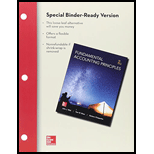
Loose Leaf for Fundamentals of Accounting Principles and Connect Access Card
22nd Edition
ISBN: 9781259542169
Author: John J Wild
Publisher: McGraw-Hill Education
expand_more
expand_more
format_list_bulleted
Concept explainers
Textbook Question
Chapter 25, Problem 16E
Exercise 25-16
Relevant costs
C1
Complete the following descriptions using the terms a through e.
a. Opportunity cost
b. Avoidable costs
c. Sunk cost
d. Relevant benefits
e. Out-of-pocket cost
1. A ____ arises from a past decision and cannot be avoided or changed; it is irrelevant to future decisions.
2. ___ refer to the incremental revenue generated from taking one particular action over another.
3. Relevant costs are also known as ___ .
4. An ___ requires a future outlay of cash and is relevant for current and future decision making.
5. An ___ is the potential benefit lost by taking a specific action when two or more alternative choices are available.
Expert Solution & Answer
Want to see the full answer?
Check out a sample textbook solution
Students have asked these similar questions
Please help with question is accounting
ned help this questions
Please given answer
Chapter 25 Solutions
Loose Leaf for Fundamentals of Accounting Principles and Connect Access Card
Ch. 25 - Prob. 1DQCh. 25 - What is capital budgeting?Ch. 25 - Prob. 3DQCh. 25 - Prob. 4DQCh. 25 - Prob. 5DQCh. 25 - Prob. 6DQCh. 25 - Prob. 7DQCh. 25 - Prob. 8DQCh. 25 - Prob. 9DQCh. 25 - Prob. 10DQ
Ch. 25 - Prob. 11DQCh. 25 - Prob. 12DQCh. 25 - Prob. 13DQCh. 25 - Prob. 14DQCh. 25 - Prob. 15DQCh. 25 - Prob. 1QSCh. 25 - Prob. 2QSCh. 25 - Prob. 3QSCh. 25 - Prob. 4QSCh. 25 - Prob. 5QSCh. 25 - Prob. 6QSCh. 25 - Prob. 7QSCh. 25 - Prob. 8QSCh. 25 - Prob. 9QSCh. 25 - Prob. 10QSCh. 25 - Prob. 11QSCh. 25 - Prob. 12QSCh. 25 - Prob. 13QSCh. 25 - Prob. 14QSCh. 25 - Relevant costs C1 Label each of the following...Ch. 25 - Prob. 16QSCh. 25 - Prob. 17QSCh. 25 - Prob. 18QSCh. 25 - Prob. 19QSCh. 25 - Sell or process further Al Holmes Company produces...Ch. 25 - Prob. 21QSCh. 25 - Prob. 22QSCh. 25 - Prob. 23QSCh. 25 - Prob. 24QSCh. 25 - Prob. 25QSCh. 25 - Prob. 26QSCh. 25 - Prob. 27QSCh. 25 - Prob. 1ECh. 25 - Prob. 2ECh. 25 - Prob. 3ECh. 25 - Prob. 4ECh. 25 - Prob. 5ECh. 25 - Prob. 6ECh. 25 - Prob. 7ECh. 25 - Prob. 8ECh. 25 - Prob. 9ECh. 25 - Prob. 10ECh. 25 - Prob. 11ECh. 25 - Prob. 12ECh. 25 - Prob. 13ECh. 25 - Prob. 14ECh. 25 - Prob. 15ECh. 25 - Exercise 25-16 Relevant costs C1 Complete the...Ch. 25 - Prob. 17ECh. 25 - Prob. 18ECh. 25 - Prob. 19ECh. 25 - Prob. 20ECh. 25 - Prob. 21ECh. 25 - Prob. 22ECh. 25 - Prob. 23ECh. 25 - Prob. 24ECh. 25 - Prob. 25ECh. 25 - Prob. 26ECh. 25 - Prob. 27ECh. 25 - Prob. 1APSACh. 25 - Prob. 2APSACh. 25 - Prob. 3APSACh. 25 - Prob. 4APSACh. 25 - Prob. 5APSACh. 25 - Prob. 6APSACh. 25 - Prob. 1BPSBCh. 25 - Prob. 2BPSBCh. 25 - Prob. 3BPSBCh. 25 - Prob. 4BPSBCh. 25 - Prob. 5BPSBCh. 25 - Prob. 6BPSBCh. 25 - Prob. 25SPCh. 25 - Prob. 1BTNCh. 25 - Prob. 2BTNCh. 25 - Prob. 3BTNCh. 25 - Payback period, accounting rate of return, net...Ch. 25 - Many companies must determine whether to...Ch. 25 -
BTN 25-6 Break into teams and identify four...Ch. 25 - Prob. 7BTNCh. 25 - Prob. 8BTNCh. 25 - Access Samsung's 2013 Corporate Sustainability...
Knowledge Booster
Learn more about
Need a deep-dive on the concept behind this application? Look no further. Learn more about this topic, accounting and related others by exploring similar questions and additional content below.Similar questions
- What is income under full costing?arrow_forwardHello tutor solve this question accountingarrow_forwardDefine in detail the following in relation to Organizational Ethics. The Ethical Culture of an organization. Define these Five Signs of Ethical Collapse a) Pressure to maintain the numbers b) Fear of reprisals c) Loyalty to the boss d) Innovations e) Goodness in some areas, atones for evil in othersarrow_forward
arrow_back_ios
SEE MORE QUESTIONS
arrow_forward_ios
Recommended textbooks for you
 Financial Accounting: The Impact on Decision Make...AccountingISBN:9781305654174Author:Gary A. Porter, Curtis L. NortonPublisher:Cengage Learning
Financial Accounting: The Impact on Decision Make...AccountingISBN:9781305654174Author:Gary A. Porter, Curtis L. NortonPublisher:Cengage Learning

Financial Accounting: The Impact on Decision Make...
Accounting
ISBN:9781305654174
Author:Gary A. Porter, Curtis L. Norton
Publisher:Cengage Learning
Cost Classifications - Managerial Accounting- Fixed Costs Variable Costs Direct & Indirect Costs; Author: Accounting Instruction, Help, & How To;https://www.youtube.com/watch?v=QQd1_gEF1yM;License: Standard Youtube License